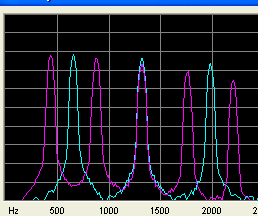The Diatonic (harmonic) scale of Ptolemy
Ptolemy was a Greek astronomer living 100-170 AD. He is most known for presuming that the earth was in the center of the universe. (This lead to that the earlier and correct presumption that the sun was in the center, was forgotten) His discoveries in music unfortunately was forgotten until they were discovered by Gauffurio in Italy, who told Zarlino that founded the western school of harmony. Ptolemy based his knowledge on Pythagoras, and like him he meant that there was a connection between music and the planetary movements. Ptolemy made a lot of experiments. Here is a listing of his scales.
Mersenne followed up on Zarlino and stipulated the "Just intonation" scale.
When you put your finger on 1/2 of a string you get an octave.
When you put your finger on 1/3 of a string (so there is 2/3 back) you get a fifth
When you put your finger on 1/4 of a string (so there is 3/4 back of the string) you get a fourth
When you put your finger on 1/5 of a string (so there is 4/5 back of the string) you get a major third
When you put your finger on 1/6 of a string (so there is 5/6 back of the string) you get a minor third.
These intervals are physically more correct than the earlier Pythagorean intervals.When you listen to them you will find that the overtones coincides.
For some reason the 7th harmonic does not sound very well.
A major chord consists of the whole string and then a finger put on 1/5, 1/3 and 1/2 of the string according to above scheme. This is called a tetra chord in Greek. The Greek word tetrachord has later transformed into the word chord.
He also found that the intervals 1/6, 1/3 and 1/2 Sound good. This is a minor chord.
If you use the fifth as a root for your cord, you will create a dominant tetrachord.
If you use the fourth as root for your chord you will create the subdominant tetrachord.
You have now created a scale 7 tones. (Taking the fifth of the fifth and move it one octave down calling it a whole note)
Using the 1/6, 1/3 1/2 sequence will produce a minor scale
It is easy to mathematically derive the tones. Simply multiply the string relations. (Or if you prefer multiply the inverse relation which is the frequency relation.)
The diatonic scale can thus be written
| Interval name | unison | whole tone | major third | fourth | fifth | major sixth | Major seventh (lead tone) | Octave |
| Tone | 1 | 2 | 3 | 4 | 5 | 6 | 7 | 8 |
| Derivation | Root | Fifth+fifth | major third | fourth | fifth | fourth + major third | fifth + major third | fourth + fifth |
| Fingers position | whole string | 1/9 | 1/5 | 1/4 | 1/3 | 2/5 | 7/15 | 1/2 |
| String length | 1 | 8/9 | 4/5 | 3/4 | 2/3 | 3/5 | 8/15 | 1/2 |
| Frequency relation | 1 | 9/8 | 5/4 | 4/3 | 3/2 | 5/3 | 15/8 | 1/2 |
| A-major Frequency |
440 | 495 | 550 | 586.666 | 660 | 733.33 | 825 | 880 |
If you have MS IE, you can listen to the prefect intervals by moving your mouse across above frequencies.
The comma of Dydimus
Put your violin in perfect tune. Play a B with the first finger on the A-string. Get it right by playing it together with the E-string. No try it with the D-string... Does it sound good? No, no. You have to lower your finger about 4 millimeters and it sounds good.
Getting from D to E there is a 9/4 -relation ship. (Two perfect fifths.Going to B you had to divide with 4/3. Going from D B you multiply with 3/5.
Putting the frequencies in relation to each other you get: (9/4)/(4/3) * 3/5 or (9*3*3)/(4*4*5)
In other words the pitch is 81/80 higher. (String length difference is 80/81) A violin string is 33 cm, so you should move your finger about 4 millimeters or a 1/4 of a semitone.

